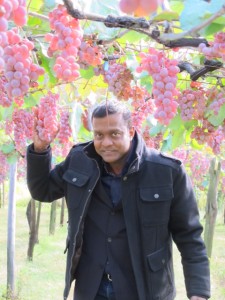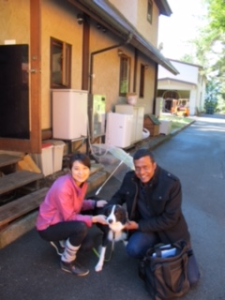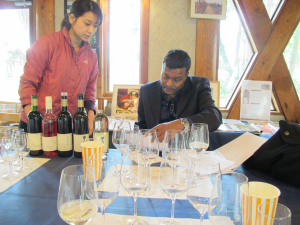Today we have a guest post from Joshua Kalinan, CWE. Joshua tells us about a fascinating trip he took to Japan’s Grace Winery!
Due to my interest in wines, I have started to explore non-traditional wine-producing regions such as in Japan, India, and Bali. The present knowledge of such regions is often limited in textbooks, so I decided that the best way to learn would be to visit and to see for myself these regions and how they are able to produce excellent wines and even win awards in international wine competitions.
My first stop on this tour is Yamanashi Vineyards, run by the Misawa Family and located in Akeno-cho, prefecture of Yamanashi, Japan. This beautiful location is on the main island of Honshu.
From the famous Shinjuku station, I took a one and a half hour train ride from the concrete jungle of Shinjuku to the scenic countryside of Kofu. It is also the same station that one has to stop in order to visit Mount Fuji.Yamanashi Perfecture is also famous for its red apples, peaches and table grapes.
From Kofu station, I was picked up by one of Ms. Misawa’s staff who drove me to Katsunuma Region where the vineyard is located. I was introduced to Ms. Ayana Misawa who, despite her busy schedule took time to introduce me to her vineyard. She also introduced to her vineyard dog that bears the same name as the Koshu grapes. She is the only female Japanese winemaker to have made a name in the male-dominated world of Japanese wine. Her father, Mr. Shinekazu Misawa, owns Grace Winery.
Ms. Misawa showed me the training system, which is known as VSP (Vertical Shoot Positioning) where the Koshu grapes are trained. According to Ms. Misawa, by adopting VSP the berries are more concentrated. Beside the signature Koshu grapes other varietals such as Cabernet Sauvignon, Merlot, Cabernet Franc, and Petit Verdot are also grown on the Misawa vineyard. The soil structure consists of a mixture of clay and chalk with well-draining soil.
Misawa vineyard has 13.6 ha (33 acres) of vines grown at an elevation of about 700 m (2,300 feet). This region has its longest sunshine hours from April to October, which is necessary to ripen the grapes. I visited in October, when the harvest has started earlier previous years.
Ms. Misawa patiently gave me tour of all the different types of grape varieties, its terroir and the ridge system where these varieties are planted. After the tour of the vineyard, we toured the winery where I had the chance to see their state-of-the-art stainless steel fermentation tanks. Ms. Misawa also showed me their new French barriques that are being used for Chardonnay, rosé, and the red varietals such as Cabernet Sauvignon and Merlot. The signature Koshu is usually fermented in stainless steel tanks to preserve the fruit and its freshness.
The grand finale of my tour was a tutored tasting of the following wines:
- 2012 Grace Gris De Koshu – This wine won the Gold medal at the Decanter Asia wine award for 2013.
- 2012 Grace Koshu Torriibira Vineyard
- 2012 Cuvee Misawa Koshu Akeno Vineyard
- 2011 Grace Chardonnay
- 2012 Grace Rosé – This is a serious, dry rosé made using Cabernet Sauvignon and Cabernet Franc.
- 2009 Cuvee Misawa Rouge – This is a full-bodied, Bordeaux-style blend of Cabernet Sauvignon and Merlot. .
After tasting a myriad of wines, I came to a conclusion that Grace Winery wines are suited for an Aperitif, as well as being food- friendly wines. My take-home lesson was not to underestimate the potential of these wines that have made a mark in international wine competitions.
Another interesting lesson is the ability of these wines to match with Asian cuisine, which can be trickier than pairing to western foods. This is more so for the Koshu wines where they are let to rest on its lees for five months before bottling which gives an extra dimension of richness and delicate aromas. The fine characteristics of these wines are a perfect match not only for Japanese cuisine such as sushi and sashimi but also Chinese cuisine such as tofu dishes.
The key characteristics of Koshu lie on the watery lemon yellow appearance and the nose of citrus fruits of Yuzu (Japanese Yuzu), white peaches, and white flowers.
Without the kind assistance of Ms. Misawa, I would not have had the chance to add more knowledge to my wine adventure. I would like to conclude that after this unforgettable visit, I have come to describe Koshu wine as “the Sauvignon Blanc of Asia” and, of course, “Asia’s Hidden Gem”.
Click here for more information on Grace Winery, Yamanashi Vineyards, and the Koshu grape variety.
Joshua Kalinan, CWE has been involved in wine education for more than 10 years in Singapore. He achieved his CWE qualification in July 2014 and has since been busy tweeting his his interest in wine and wine and food pairing. In addition to the CWE, Joshua is a Certified Sommelier with the Court of Master Sommeliers , UK; a Certified Wine Professional via the Culinary Institute of America, and a Certified Sake Sommelier with the Sake Sommelier Association of the UK. In his free time, Joshua loves to cook and pair wines with his favorite cuisine. You can follow joshua @winetimesg on Twitter.
Are you interested in being a guest blogger or a guest SWEbinar presenter for SWE? Click here for more information


